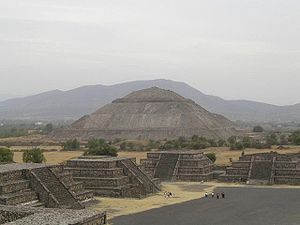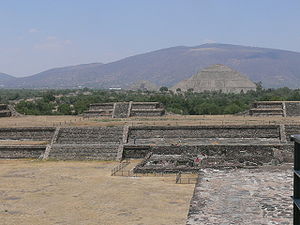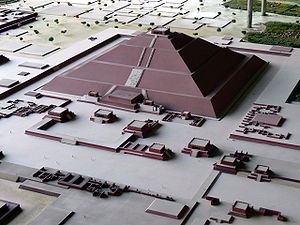
Pyramid of the Sun
Encyclopedia

Teotihuacan
Teotihuacan – also written Teotihuacán, with a Spanish orthographic accent on the last syllable – is an enormous archaeological site in the Basin of Mexico, just 30 miles northeast of Mexico City, containing some of the largest pyramidal structures built in the pre-Columbian Americas...
and one of the largest in Mesoamerica
Mesoamerica
Mesoamerica is a region and culture area in the Americas, extending approximately from central Mexico to Belize, Guatemala, El Salvador, Honduras, Nicaragua, and Costa Rica, within which a number of pre-Columbian societies flourished before the Spanish colonization of the Americas in the 15th and...
. Found along the Avenue of the Dead, in between the Pyramid of the Moon
Pyramid of the Moon
The Pyramid of the Moon is the second largest pyramid in Teotihuacan after the Pyramid of the Sun. It is located in the western part of Teotihuacan and mimics the contours of the mountain Cerro Gordo, just north of the site...
and the Ciudadela, and in the shadow of the massive mountain Cerro Gordo
Cerro Gordo
Cerro Gordo may refer to several places:Mexico*Cerro Gordo, Veracruz**The Battle of Cerro Gordo in the Mexican-American War*Cerro Gordo, the mountain north of TeotihuacanPuerto Rico...
, the pyramid is part of a large complex in the heart of the city.
History


feet (225 meters) across and 246 feet (75 meters) high, making it the third largest pyramid in the world, being slightly smaller than Great Pyramid of Giza
Great Pyramid of Giza
The Great Pyramid of Giza is the oldest and largest of the three pyramids in the Giza Necropolis bordering what is now El Giza, Egypt. It is the oldest of the Seven Wonders of the Ancient World, and the only one to remain largely intact...
(230 meters), but much smaller than the Great Pyramid of Cholula
Great Pyramid of Cholula
The Great Pyramid of Cholula, also known as ' , is a huge complex located in Cholula, Puebla, Mexico. It is the largest archaeological site of a pyramid in the New World. The pyramid stands above the surrounding plain, and in its final form it measured...
(450 meters). The second phase also saw the construction of an altar atop of the pyramid, which has not survived into modern times. The Adosada platform was added to the pyramid in the early third century, at around the same time that the Ciudadela and Temple of the Feathered Serpent, Teotihuacan Pyramid of the Feathered Serpent were constructed.
Over the structure the ancient Teotihuacanos finished their pyramid with lime plaster imported from surrounding areas, on which they painted brilliantly colored murals. While the pyramid has endured for centuries, the paint and plaster have not and are no longer visible. Few images are thought to have been included in the mural decorations on the sides of the pyramid. Jaguar heads and paws, stars, and snake rattles are among the few images associated with the pyramids.
It is thought that the pyramid venerated a deity within Teotihuacan society but the destruction of the temple on top of the pyramid, by both deliberate and natural forces prior to the archaeological study of the site, has so far prevented identification of the pyramid with any particular deity. However, little evidence exists to support this theory.
Structure measurements, location and orientation
| Dimension | Value |
|---|---|
| Height | 233.5 feet (71.2 m) |
| Base perimeter | 2932.8 feet (893.9 m) |
| Side | 733.2 feet (223.5 m) |
| 1/2 Side | 366.6 feet (111.7 m) |
| Angle of slope | 32.494 |
| Lateral Surface Area | 637370.76 feet (194,270.6 m) |
| Volume | 41841817 feet (12,753,385.8 m) |

Maya civilization
The Maya is a Mesoamerican civilization, noted for the only known fully developed written language of the pre-Columbian Americas, as well as for its art, architecture, and mathematical and astronomical systems. Initially established during the Pre-Classic period The Maya is a Mesoamerican...
long-count calendar. In addition, many important astrological events can be viewed from the location of the pyramid that are important in terms of both agriculture and belief systems of the ancient society.
The pyramid was built over a man-made tunnel leading to a "cave" located six meters down beneath the center of the structure. Originally this was believed to be a naturally formed lava tube
Lava tube
Lava tubes are natural conduits through which lava travels beneath the surface of a lava flow, expelled by a volcano during an eruption. They can be actively draining lava from a source, or can be extinct, meaning the lava flow has ceased and the rock has cooled and left a long, cave-like...
cave and interpreted as possibly the place of Chicomoztoc
Chicomoztoc
Chicomoztoc is the name for the mythical origin place of the Aztec Mexicas, Tepanecs, Acolhuas, and other Nahuatl-speaking peoples of the central Mexico region of Mesoamerica, in the Postclassic period....
, the place of human origin according to Nahua legends
Aztec mythology
The aztec civilization recognized a polytheistic mythology, which contained the many deities and supernatural creatures from their religious beliefs. "orlando"- History :...
. More recent excavations have suggested that the space is man-made and could have served as a royal tomb. Recently scientists have used muon
Muon
The muon |mu]] used to represent it) is an elementary particle similar to the electron, with a unitary negative electric charge and a spin of ½. Together with the electron, the tau, and the three neutrinos, it is classified as a lepton...
detectors to try to find other chambers within the interior of the pyramid, but substantial looting has prevented the discovery of a function for the chambers in Teotihuacan society.
Recovered artifacts
Only a few caches of artifacts have been found in and around the pyramid. ObsidianObsidian
Obsidian is a naturally occurring volcanic glass formed as an extrusive igneous rock.It is produced when felsic lava extruded from a volcano cools rapidly with minimum crystal growth...
arrowheads and human figurines have been discovered inside the pyramid and similar objects have been found at the nearby Pyramid of the Moon
Pyramid of the Moon
The Pyramid of the Moon is the second largest pyramid in Teotihuacan after the Pyramid of the Sun. It is located in the western part of Teotihuacan and mimics the contours of the mountain Cerro Gordo, just north of the site...
and Pyramid of the Feathered Serpent
Temple of the Feathered Serpent, Teotihuacan
The Temple of the Feathered Serpent is the modern-day name for the third largest pyramid at Teotihuacan, a pre-Columbian site in central Mexico. This structure is notable partly due to the discovery in the 1980s of more than a hundred possibly-sacrificial victims found buried beneath the...
in the Ciudadela. These objects may have represented sacrificial victims. In addition, burial sites of children have been found in excavations at the corners of the pyramid. It is believed that these burials were part of a sacrificial ritual dedicating the building of the pyramid.

